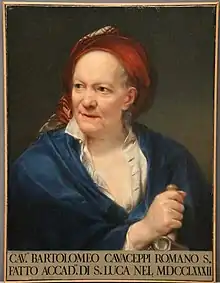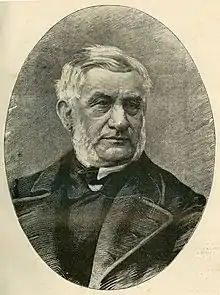Torlonia Collection
The Torlonia Collection (Italian: Collezione Torlonia) is a private art collection of 620 Ancient Greek and Roman art works assembled by the noble Torlonia family of Rome, Italy. It has been called "the greatest private collection of ancient Roman antiquity" by archaeologist Darius Arya.[1][2] Around 180 pieces are busts, one of the largest collections of Roman portraiture in the world.[3]
History
Referred to as a "collection of collections" by the archaeologist Salvatore Settis,[3] much of the Torlonia Collection consists of older collections acquired either whole or in part by Prince Giovanni (1754-1829) and his son Prince Alessandro (1800-1886). Acquisitions of individual works and groups of classical art were also made on the art market, and the family conducted extensive excavations on its own properties in and around Rome to unearth further antiquities for the collection.[1]
Acquisitions

In 1800, Prince Giovanni acquired the contents of the studio of the 18th century sculptor-restorer Bartolomeo Cavaceppi, who had died the previous year. The ancient part of the collection consisted of a thousand pieces of sculpture, busts, reliefs, decorative and architectural fragments. There was also an array of modern sculptures executed by Cavaceppi, modern copies of antique sculpture, paintings, plaster casts, clay models and maquettes.[4]
In 1816, 269 statues from the collection assembled by the 17th century art collector and aristocrat Vincenzo Giustiniani (1564-1637), were transferred to Giovannia Torlonia as collateral on a loan. After 1825, following Prince Vincenzo Giustiniani's failure to uphold the terms of his agreement, the Torlonias entered into a long legal dispute which concluded with the sculptures coming into Torlonia possession between 1856-1859.[5][6] Some of the highlights which came from the Giustiniani Collection were a series of imperial busts and portraits, the Giustiniani Hestia, and the "Euthydemus of Bactria".[7]
In 1866, the Villa Albani and its collections were also purchased. This collection had been assembled by Cardinal Alessandro Albani, under the curatorship of the classical art scholar and archaeologist Johann Joachim Winckelmann.[8] One of the outstanding pieces belonging to the Villa Albani collection is the Torlonia Vase, a marble krater resting on carved lions' feet with a relief around its sides depicting a Bacchic symposium. It is believed to have adorned the Horti Agrippinae, the gardens of Agrippina the Elder between the Janiculum Hill and the Vatican plain. Before passing into the possession of Cardinal Albani and thence to Alessandro Torlonia, the vase belonged to the sixteenth-century Cesi Collection.[9] The Albani collection also included a relief with Antinous taken from Hadrian's Villa, and a Roman bronze statuette of the Apollo Sauroctonos, after an original by the Greek sculptor Praxiteles.[10]
Excavations

The Torlonias excavated ancient ruins on their estate of Roma Vecchia, which housed sites like the Villa of the Quintilii and the Villa dei Sette Bassi, off of the Appian Way, and the Villa of Maxentius on the Via Latina.[11][12] Some of the sculptures uncovered from these sites include an Attic relief from the slopes of the Acropolis in Athens, probably brought to Rome in the 2nd century AD by Herodes Atticus, a statuary group of Eirene and Ploutos made after an original by the sculptor Cephisodotus the Elder, and a group known as the "Invitation to the Dance" featuring a nymph and satyr.[13]
Between 1827 and 1828 excavations were carried out around Anzio, and additional work was undertaken on the Torlonia estates of Caffarella, Quadraro, and at Portus, the site of imperial Rome's most important port.[14][15] The finds from these estates were moved to the Palazzo Bolognetti-Torlonia, then brought to the Torlonia Museum after it was founded. Alessandro Torlonia acquired further property in Rome and its vicinity, including the Vigna dei Gesuiti on the Aventine Hill, which rested above the remains of the Baths of Decius.[16] Other estates acquired for excavation were at Tuscia and Sabina; at Fara Sabina (ancient Cures), the collection's bronze statue of Germanicus was discovered.[1][17]
Museum

In 1875, Prince Alessandro founded the Torlonia Museum on Via della Lungara in the Trastevere neighborhood of Rome. In that year the collection consisted of 517 works - new additions continued to be made until 1884, when the collection numbered 620 sculptures.[18] The museum was only accessible to small groups of visitors and access by scholars was limited.[3] A catalogue of the collection, authored by Pietro Ercole Visconti and featuring phototypes of all 620 works, was published in 1884. Prince Alessandro arranged for this catalogue to be donated to private individuals and to the libraries of archaeological institutes, in order to "bring it [the collection] in a splendid manner...to the notice of archaeologists, scholars, and all those who lack the opportunity to have it often before them."[19][20]
Exhibition
In 2013, Prince Alessandro Torlonia (1925-2017)[21] established the Torlonia Foundation to manage the collection. In 2016, the family, the foundation, and the Italian government signed an accord to display the collection.[1] Restoration work sponsored by the Italian luxury house Bulgari, primarily to remove thick accumulations of dust, also began in 2016.[3]
In October 2020, an exhibition of 92 works from the Torlonia Collection opened at the Capitoline Museums in Rome, the first public display of works from the Torlonia Collection in decades, and came after a series of failed negotiations between the Torlonia family and the Italian government over displaying or purchasing the collection dating back to the 1960s.[1] After the exhibition was prolongued and finally came to an end in Rome, it was shown in Milano at the Gallerie d'Italia. It is due to travel through Europe and the United States.
References
- Elisabetta Povoledo (2020-10-14). "Long Unseen Trove of Ancient Treasures Goes on Show in Rome". Retrieved 2021-04-26.
- CBS Sunday Morning (2021-03-21). Ancient art returns to public view in Rome. YouTube.com. Retrieved 2021-05-02.
- Elisabetta Povoledo (2019-10-28). "A Storied Collection of Ancient Sculpture Will Finally See the Light". New York Times. Retrieved 2021-04-26.
- Carlo Gasparri (2021). "The Torlonia Museum: The Last Roman Collection of Antique Sculpture". Vol. The Torlonia Marbles. Collecting Masterpieces. Rizzoli Electa. p. 34-35.
- Carlo Gasparri (2021). "The Torlonia Museum: The Last Roman Collection of Antique Sculpture". Vol. The Torlonia Marbles. Collecting Masterpieces. Rizzoli Electa. p. 37.
- Vademecum: The Torlonia Marbles Collecting Masterpieces (PDF). www.electa.it. p. 14.
- "Purchase of Part of the Giustiniani Collection". www.fondazionetorlonia.org. Retrieved 2021-04-30.
- "Purchase of Villa Albani". www.fondazionetorlonia.org. Retrieved 2021-04-28.
- "CESI TORLONIA CUP, CRATER WITH BACCHIC SYMPOSIUM, KNOWN AS THE CESI CUP OR TORLONIA VASE". fondazionetorlonia.org. Retrieved 2021-05-10.
- Daniella Porro. Tutelage of the Torlonia Collection. Vol. The Torlonia Marbles. Collecting Masterpieces. Rizzoli Electa. p. 49.
- "EXCAVATIONS FROM THE ESTATE OF ROMA VECCHIA, ORTI CESARINI, VULCI, MUSIGNANO, CECCHIGNOLA, TORRICOLA AND PORTO". Fondazione Torlonia. Retrieved 2021-04-26.
- Vademecum: The Torlonia Marbles Collecting Masterpieces (PDF). www.electa.it. p. 6.
- Vademecum: The Torlonia Marbles Collecting Masterpieces (PDF). www.electa.it. p. 7-8.
- "Excavations carried out on the estate of Roma Vecchia, Caffarella, Quadraro, Anzio". www.fondazionetorlonia.org. Retrieved 2021-04-27.
- Vademecum: The Torlonia Marbles Collecting Masterpieces (PDF). www.electa.it. p. 6.
- Gasparri, 2021; p. 39
- Vademecum: The Torlonia Marbles Collecting Masterpieces (PDF). www.electa.it. p. 6.
- "Portrait Gallery". www.fondazionetorlonia.org. Retrieved 2021-04-30.
- C.L. Visconti (1884). I Monumenti del Torlonia Museum riprodotti con la fototipia. p. vi.
- Salvatore Settis (2021). "A Collection of Collections. The Torlonia Museum and the Collection of Antiquities in Rome". Vol. The Torlonia Marbles. Collecting Masterpieces. Rizzoli Electa. p. 22.
- Gasparri, 2021; p. 31